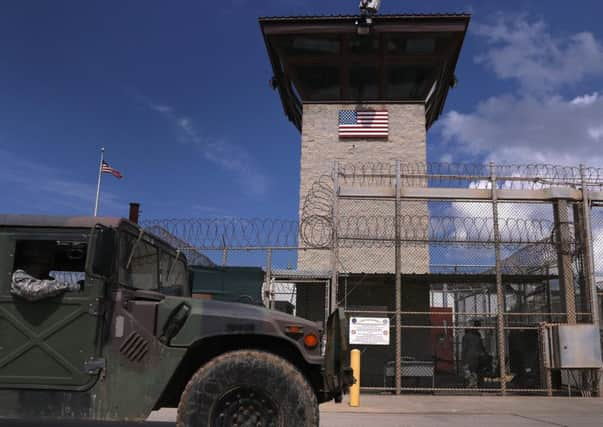Insight: Inside notorious Guantanamo detention centre


My flight from Andrews Air Force Base in Maryland carries prosecutors, defence lawyers, family members of victims of 9/11 and NGO observers. When our feet hit the tarmac there is a relative hush over the group, many of whom, like me, are first-timers to this infamous place. Instead of lively travel escorts, the plane is met by military personnel and an air of solemnity. I am overwhelmed by the idea that unlike the 780 men held at Guantanamo Bay detention centre since 2002, I have entered, and will depart, by choice.
The world appears to have largely forgotten that five men are currently on trial here for mass murder and war crimes relating to the planning and facilitation of the attacks of 11 September, 2001. The alleged mastermind of the plot is Khalid Sheik Mohammad or KSM, and I have travelled to the 45 square-mile section of Cuba held by the US to observe proceedings to try to understand the extent to which torture was used by the US government to extract information from suspected terrorists during the Bush administration.
Advertisement
Hide AdAdvertisement
Hide AdPerhaps one reason the controversial detention centre has faded from public view has been President Barack Obama’s early commitment to closing it, but his successor, Donald Trump, opposed any such closure during his election campaign and it looks set to remain a source of controversy.


Late May in Guantanamo is oppressively hot. The salt in the air is palpable as the wind violently whips all loose items. By the time I show my passport to the fatigue clad young man in the terminal, I am desperate for water, which fortunately seems in unlimited supply. JTF-GTMO (see panel overleaf) handlers hurry us to vans freezing with maximum air conditioning. A ferry journey in the heat of the sun to the opposite side of the bay is the next leg. Rule 1 of Guantanamo, do not photograph features of the military installation, is repeated incessantly. The smell of the sea is intermittently polluted by gas fumes from the ferry and the blue waters and palm trees are pockmarked by military infrastructure and functional architecture. It is the most incongruous island arrival one could imagine.
The final leg of journey takes us to Camp Justice, where my days will be spent. In a long-disused aircraft hangar, the necessities of existing on a military base fill the first hours in the chilly pressroom, including a review of the rules, the issuing of visitor badges, a reiteration of the rules, and a tour of the tent village where I will be housed for the duration of my stay. The multiple rows of semi-permanent canvas tents, each of which accommodates up to eight trial observers, look like they’ve come from the set of M.A.S.H. I am mesmerised by the order and delivery of information practised by JTF-GTMO. A glance at the $12 million purpose-built courtroom compound and its layers of concertina wire pulls me sharply back to reality.
Day one in court highlights the absurdity that surrounds Guantanamo. To be seated in the observation gallery in advance of “gavel down” at 09:00 we convene just before 08:00 for the drive to the courtroom, a mere 40 metres from our tents and 20 metres from the hangar. More disconcerting is the insistence on driving us to the security entrance two minutes around the corner, though no-one can give a straight answer as to why this is necessary.
After all security procedures are performed in a tent-shaped refrigerator, we are ushered through an outdoor corridor that delivers a short reprieve from the cold. Like the external perimeter of the compound, the corridor is lined by concertina wire and opaque fencing. My stomach is in knots on the first day as I proceed down the corridor. My palms are sweaty, not because I am nervous, but because I am trying to imagine a life where this is the norm, just like the life of the men detained here. Our small group of first-timers try to make light of the intimidating security structures but our voices fall flat with the effort.


Three layers of soundproof glass separate the gallery from the courtroom where the proceedings are filtered through CCTV on a 40-second delay to prevent classified information “spills”. There is a buzz among the observers as the press is joined by NGO representatives and, finally, victims’ family members. I have not seen the family members since the plane, when I didn’t realise who they were, and now the dynamics of the aircraft seating plan begin to make sense.
They are guests of the US government, the prosecution, and they apply to travel to Guantanamo through a ballot system open to all immediate family members of the almost 3,000 individuals killed on 9/11. Some are here for the first time and you can see the anguish of the situation etched on their faces. Though it has been almost 15 years, the arrival of the defendants underscores the nightmare that these family members have lived with for all of those years. It does not take long to understand why they sit on the opposite side of a retractable curtain partition that can be drawn as necessary throughout the proceedings. As soon as the first defendant arrives, the horror of 11 September hits many of these people again and I, along with my new colleagues among the observers and the press, avoid glancing in their direction in respect of their loss.
The five defendants are brought in one by one, shackled until just outside the courtroom. They are being tried collectively as co-conspirators in the 9/11 terrorist attacks on the US. They are unremarkable, save KSM himself, who has stained his beard orange by some means that no-one seems to be able to ascertain. They look small, rather uninterested and cold. Defendants and lawyers repeatedly request a temperature adjustment. The chill is revealed as a point of contention as one defendant becomes animated about the freezing temperatures in the courtroom, the holding cell outside and his regular cell. I admit I agree with him and think that a few degrees increase in temperature would save the US taxpayers some money and allow us to think straight – but maybe that is the point.
Advertisement
Hide AdAdvertisement
Hide AdDay one is the only day where all five KSM defendants are present as each may waive his right to attend the trial following the opening session. I am intrigued by this, however, the explanation of why reminds me why I am here. The effects of the torture they suffered make it impossible for some of them to sit for extended periods.


Two years in, the KSM case is only in the pre-trial phase. As the lawyers debate issues throughout the week, it is clear that torture will dominate the proceedings, however long it takes – an estimated further six to eight years. Medical treatment of injuries received during “enhanced interrogation”, continuing sleep deprivation claims, the mental state of torture victims and a visit by the UN Special Rapporteur on Torture are just a few of the issues raised during the week. These courtroom arguments give us a glimpse of the detention that these men, along with many others, have endured for the past ten to 15 years.
It is these issues that are discussed by the press and NGO observers into the wee hours of the morning. In two meetings with the family members, it is clear that these are not shared concerns. Understandably, their grief is their main focus. Though several of the family members speak out courageously against the torture suffered by countless innocent men who have passed though CIA black sites and Guantanamo, the phrase “an eye for an eye” is repeated by others. It is these meetings that I find the most difficult, torn between what is right in law and the emotional turbulence that accompanies any mass tragedy.
There is a limited amount of time in which to explore the base that is home to roughly 3,000 regular naval personnel. There is an outdoor movie theatre and well-maintained sports facilities for the activity-hungry military who appear to spend most of their off-duty time playing baseball, football, volleyball or lifting weights at the gym. Four restaurants offer a variety of mediocre food and wi-fi, including a typically styled Irish pub, O’Malley’s, where the beer is cold and the pub grub is on par with any Wetherspoons. It is painfully clear that after hours, no-one gives a second thought to the wider world’s concerns over Guantanamo and what happens there.
It is disturbing that a posting at Guantanamo – commonly dubbed “Gitmo” – is considered idyllic with palm trees, sand and sun, but without any acknowledgement that men have been tortured just a few short miles from where recruits are eating their cheeseburgers. On a tour of the island this stark reality is highlighted by a visit to Windmill beach. It is a popular sunspot where the enlisted frolic, just in sight of Camp Iguana, which was first home to the small number of under-18s rounded up in the post-9/11 chaos. The beauty of the beach is immediately tarnished.


In a fleeting drive by Camp X-Ray, where the first detainees were brought in February 2002, I am disturbed that the crumbling remnants of the facility suggest little more than tin cladding over chain fences offering less protection than most would afford their farm animals. I am not sure if it is the heat, or the combination of truths suggested by the contradictions of Guantanamo, but I feel uneasy and slightly ill. The single road running beside the defunct Camp X-Ray leads either to Cuba or back to the centre of the base, where the local tourist shop offers shot glasses and hats proclaiming “It don’t GTMO better than this!” in bright colours alongside black t-shirts supporting “Operation Enduring Freedom” detention operations. This drives home the paradox that is Guantanamo. Twenty-nine of the remaining 59 detainees have been declared “forever prisoners” which suggests for them, it does not “GTMO better than this”.
• Kasey McCall-Smith is a lecturer in public international law and director of the LLM in Human Rights at the University of Edinburgh. She travelled to Guantanamo Bay Detention Camp as part of a research project entitled “Getting to Grips with Guantanamo”.